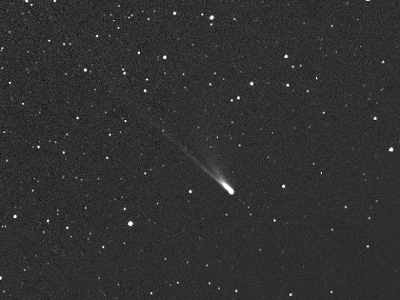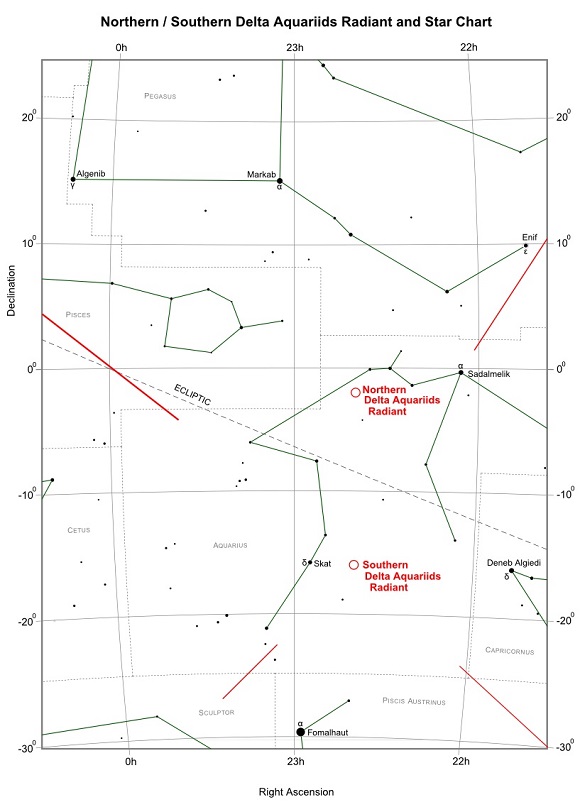The Delta Aquarids or Delta Aquariids is an annual meteor shower that takes place every year in July and August. It consists of two branches, the Northern Delta Aquariids and the Southern Delta Aquariids. Of these the Southern Delta Aquariids is the stronger brighter stream with this year's event taking place from July 12th to August 23th. Peak activity occurs on the night of July 28th / 29th where normally up to 16 meteors per hour are expected (Zenithal Hourly Rate). Unfortunately, this year the 91% illuminated waxing Gibbous Moon will significantly interfere. The shower is best seen from the tropics and Southern Hemisphere where the radiant appears higher in the sky compared to northern temperate latitudes.
The Northern stream is feeble in comparison with a maximum ZHR of 4 and peaks around August 7th.
Discovery and Parent Body
Lieutenant Colonel G. L. Tupman, a member of the Italian Meteoric Association made the first detailed recordings of Delta Aquariids meteors between July 27th and August 6th, 1870. The streams were then unidentified, but by plotting data from 65 meteors, he was to a reasonable degree of accuracy able to determine the general area of the radiant.
Between 1926 and 1933, New Zealander Ronald McIntosh improved the position of the radiant based on a greater number of observations. A few years later in 1938, Cuno Hoffmeister founder of Sonneberg Observatory, along with his German colleagues were able to first record the northern part of the stream. It was astronomer Mary Almond, in 1952, who finally confirmed the presence of the two separate radiants.
The parent body of the Southern Delta Aquariids is uncertain. However, comet 96P/Machholz or comet Machholz as it's often referred to is a possible candidate. This Jupiter family comet was discovered in 1986 by amateur astronomer Donald Machholz using just a pair of 130mm binoculars. It has an orbital period of 5.2 years.

Radiants
The shower radiants are located in the faint zodiac constellation of Aquarius, which is positioned about 30 degrees to the south and southwest of the "Square of Pegasus". The southern radiant is just over 3 degrees west of star Skat (δ Aqr - mag. 3.3), with the northern radiant a further 14 degrees to the north. The brightest star in the surrounding sky is first magnitude Fomalhaut (α PsA - mag. 1.2) in the constellation Piscis Austrinus. Fomalhaut is positioned about 14 degrees south-southeast of the southern radiant.

Delta Aquariids Radiants and Star Chart - pdf format
What to expect
The best time to observe the meteor shower is around midnight and during the early hours of the morning. Once you have located the radiant, scan the general surrounding area of sky, ideally with the Moon obscured behind a building or something similar. Observers in the southern hemisphere and tropics will get the better show; the radiant is higher in the sky from these latitudes. For those at northern temperate latitudes, the radiant appears low above the southern horizon and as a result few meteors will be seen heading southwards, unless they are fairly short and near to the radiant. Sadly the Moon will wash out all but the brightest meteors.
The meteors travel at a slow to medium velocity (41 km/s). As with all meteor showers the meteor trails often streak across the sky quite a distance from the actual radiant point, in many cases in excess of 30 degrees and therefore can effectively appear anywhere in the sky. It's therefore a good idea not to look directly at the radiant itself, but scan a large area of the sky around it.
Southern Delta Aquariids Data Table 2015
| Meteor shower name | Southern Delta Aquariids |
|---|---|
| Radiant constellation | Aquarius |
| Activity | July 12th -> August 23rd |
| Peak Date | July 29th |
| RA (J2000) | 22hr 40m |
| DEC (J2000) | -16d |
| Speed (km/s) | 41 |
| ZHR | 16 |
| Rating | Faint |
| Parent body | Uncertain but possibly comet 96P/Machholz |
| Notes | Also referred to as the Southern Delta Aquarids meteor shower |
Comet 96P/Machholz Data Table (at epoch February 17th, 1994)
| Name | 96P/Machholz |
|---|---|
| Type | Comet |
| Classification | Jupiter-family comet (NEO) |
| Discoverer | Donald Machholz |
| Discovery date | May 12th, 1986 |
| Aphelion (AU) | 5.94321 |
| Perihelion (AU) | 0.12378 |
| Orbital period (years) | 5.28362 |
| Last perihelion | July 14th, 2012 |
| Next perihelion | October 26th, 2017 |
| Notes | Also known as Comet Machholz or 96P/Machholz 1. Discovery made by amateur astronomer Donald Machholz using 130mm binoculars |